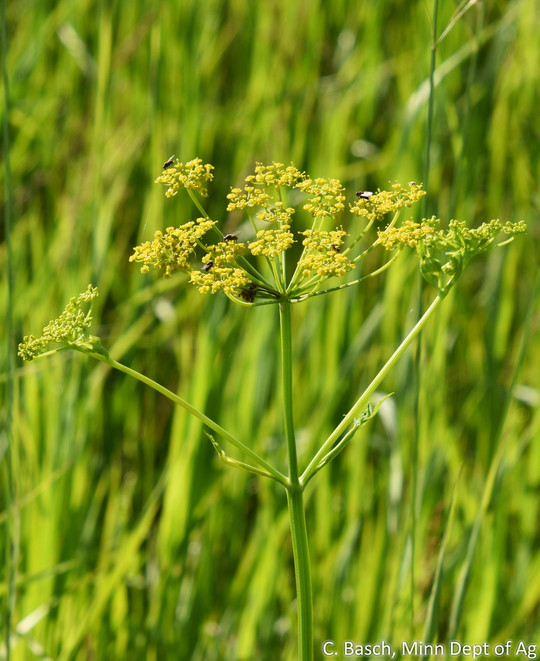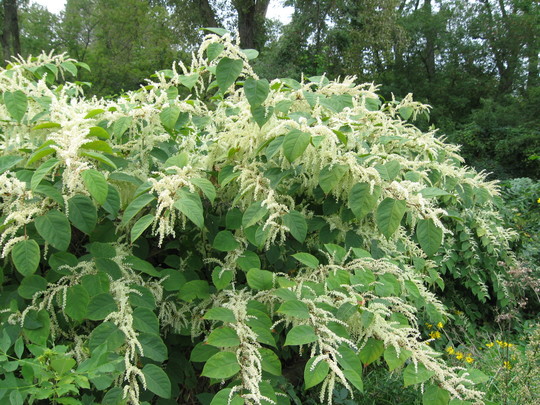|
April 30, 2020
May Weed of the Month: Pesky Plant Trackers
Abbie Anderson, University of Minnesota Department of Forest Resources
This spring, the coronavirus pandemic has everyone adjusting to uncertainty and assessing the safety of our activities. Fortunately, one safe activity is the tracking of seasonal change in living organisms, or phenology. Phenology gets us outdoors, physically active, and mentally engaged. When appropriately planned, these activities are compatible with social distancing. Most importantly, observing the natural world relieves stress and offers a welcome change of scenery.
As you observe your local scenery this spring, be on the lookout for these pesky plants: wild parsnip (Pastinaca sativa) and Japanese knotweed (Fallopia japonica). As its name denotes, wild parsnip is the feral relative to the familiar food crop. Its leaves and stems contain a toxic sap that burns exposed skin when exposed to sun. Japanese knotweed was once admired as a bamboo-like ornamental plant. However, it sprouts through concrete, propagates from small root fragments, and compromises the integrity of bridges, drains, and buildings. These two species are the focus of Pesky Plant Trackers, a new participatory science project.
 Mature wild parsnip plants send up branched stalks with flowers that are arranged in flat umbels. The flowers, which bloom in June through August, are chartreuse with five curled petals. Plants die after developing seeds.
Click here to download the image.
Pesky Plant Trackers gets people involved in tracking the seasonal changes of wild parsnip and Japanese knotweed. Why? Because timing is key to control these noxious weeds. For example, mowing wild parsnip to prevent seed maturation must be done during a narrow time window. If done too early relative to flowering, plants re-sprout. If done too late relative to flowering, seeds spread the infestation. Similarly, timing matters for controlling knotweed because the application of foliar herbicide is most effective in the late summer/early fall before frost.
Predicting plant development stages is important for the restoration of Minnesota environments. Pesky Plant Trackers works toward that greater purpose by enlisting the help of citizen scientists. The program offers participants training, resources, a platform to collect observations, and support of a community around shared goals. Participants contribute ~4 hours of time for training and ~20 minutes per week to report phenological data. Activities begin in June. Below is an outline to plan your participation or spread the word.
-
Sign-up for news of soon-to-be announced training. (link: bit.ly/peskyplants)
-
Complete online training modules to learn how to identify plants, stay safe around wild parsnip, and collect valuable data.
-
Participate by following these 4 steps:
-
Find pesky plants in your local environment
-
Join Nature’s Notebook to set up your site and species online
-
Track pesky plants at your site
-
Share your observations on Nature’s Notebook
 Japanese knotweed is a perennial plant that can form dense, leafy thickets up to 9 feet tall. Its leaf-shape and flower structure help distinguish it from similar knotweeds. Plants produce clusters of white or cream-colored flowers which bloom in August and September.
Click here to download the image.
Pesky Plant Trackers is a project by the University of Minnesota’s Department of Forest Resources. Partners include USA-National Phenology Network, the Minnesota Department of Agriculture, Minnesota Department of Natural Resources, and Minnesota Department of Transportation.
Funding is provided by Minnesota Invasive Terrestrial Pests and Plants Center through the Minnesota Environment and Natural Resource Trust Fund as recommended by the Legislative-Citizens Commission on Minnesota Resources.
For more information, visit peskyplants.umn.edu or email peskyplants@umn.edu.
MEDIA: For more information on Weed of the Month, contact Allen Sommerfeld, MDA Communications, at allen.sommerfeld@state.mn.us or 651-201-6185
Having trouble viewing this email? View it as a Web page.
|